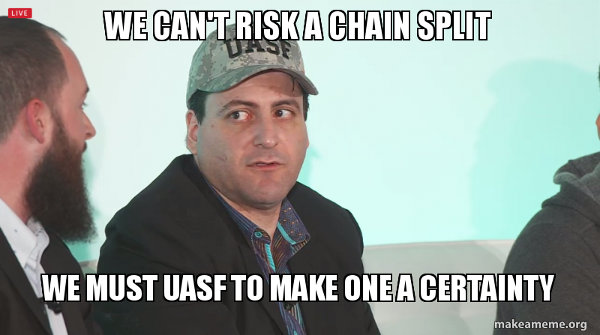Mythbusting: "Controversial hard-forks CANNOT happen"
Article is also available in:
⬤ Français
⬤ Deutsch
⬤ Polski
Preface
"It doesn't matter how beautiful your theory is, it doesn't matter how smart you are. If it doesn't agree with experiment, it's wrong. In that simple statement is the key to science."
- Richard Feynman, Cornell University Lecture, 1964
The birth of a myth

It would be exhausting to list all the arguments presented over the years by Blockstream and Bitcoin Core developers why upgrading the blocksize on Bitcoin via a hard-fork would be a terrible idea, if not impossible.
The slide above was presented to majority hashpower Chinese miners in early 2016 at an emergency summit called the "Bitcoin Roundtable Consensus" [1].
What was called "consensus" was in fact a meeting between "representatives from the bitcoin industry" - notably the Chinese miners who at the time controlled the majority of BTC's hashrate - and Blockstream's then president Adam Back, together with a handful of Bitcoin Core developers.
Developers from competing client implementations such as Bitcoin XT, Bitcoin Classic or Bitcoin Unlimited, were not invited to participate in reaching this "consensus".
The assembled parties agreed on the introduction of Segwit on BTC and that Bitcoin Core would urgently get on writing some code for a 2MB hard fork upgrade [2]:
SegWit is expected to be released in April 2016.
The code for the hard-fork will therefore be available by July 2016.
The agreement couched the future deployment of the 2MB upgrade in cautious language:
"If there is strong community support, the hard-fork activation will likely happen around July 2017."
Another notable element was a clause in which miners agreed to forego running any client software that competed with Bitcoin Core's software:
[... ] only run Bitcoin Core-compatible consensus systems, eventually containing both SegWit and the hard-fork, in production
At the time, Bitcoin Classic, which proposed an straightforward upgrade to 2MB (without SegWit), had already enjoyed considerable support of Bitcoin miners, and according to sources, reached 75% support around then.
The signatories of the Roundtable claimed to represent 90% of Bitcoin’s hash power. They agreed, behind closed doors, to activate Segwit and stop running Bitcoin Classic if Bitcoin Core agreed to write some 2MB HF code themselves. Perhaps it was a tactic on the part of miners, being unsure whether it was safe to run a fork written by a minority of the developers, to pressure the Core development group into finally acceding to a blocksize increase and writing the necessary code.
However, despite signing the agreement, Blockstream's Adam Back and the Bitcoin Core developers did not quite see fit to honor it. The rest is history:
No acceptable hard fork code was written by Blockstream / Core developers
SegWit was not activated in 2016 as not enough miners were happy with the efforts of Blockstream / Core following the Hong Kong agreement
The Bitcoin Classic effort lost mining support as a result of the anti-competitive agreement
Another project proposing a hard-fork upgrade, Bitcoin Unlimited (BU), took a more prominent place in championing a blocksize upgrade. BU proposed a method of upgrading called 'Emergent Consensus', where no fixed blocksize increase needed to be agreed beforehand by all participants on the network.
Once it became clear that the Hong Kong agreement would not be upheld, major stakeholders in the Bitcoin community launched another effort called SegWit2X in New York. This "New York Agreement" was effectively boycotted by Blockstream and Bitcoin Core.
Segwit2X was controversialized by the opposing parties, which stalled out SegWit activation as miners withheld the necessary hash votes for the proposal.
A "User Activated Soft-Fork" (UASF) effort was launched by some Bitcoin community members who wanted to see SegWit activated despite it not reaching the programmed level of network consensus. Also, they wanted to buy and sell hats.

Source: https://bitco.in/forum/threads/meme-factory.1172/page-8#post-39223 A "User Activated Hard-Fork" (UAHF) effort was announced [3] by miners and community members who wanted to see an increase to the blocksize and saw a need for a contingency plan to counteract risks posed by UASF. They saw UASF as "an attack against users and enterprises who disagree with activating SegWit right now without a block size increase". It was widely predicted that once SegWit activated, all further calls for the 2MB hard-fork component of SegWit2X would be strongly resisted by Core et al.
On July 22, the SegWit soft-fork was locked in on the Bitcoin network via BIP91. It activated a few weeks later, on August 24, 2017.
Based on UAHF, Bitcoin Cash hard-forked (and split off) on August 1 with an upgrade to 8MB and without Segwit.
On November 8, 2017, SegWit2x was officially canceled, i.e. hopes of a 2MB upgrade on BTC were given up.
Meanwhile, Ethereum (or the DAO) steals the hard-forking limelight
"[On] June 17, 2016, a hacker found a loophole in the coding that allowed him to drain funds from The DAO. In the first few hours of the attack, 3.6 million ETH were stolen, the equivalent of $70 million at the time."
- Samuel Falkon, "The Story of the DAO — Its History and Consequences", 24 Dec 2017
On or around 20 July 2016, Ethereum (ETH) did a hard fork to send stolen hacked DAO funds back to available to the original owners. [4, 5]
The move was preceded by a greatly controversial discussion over the topic of blockchain immutability in the Ethereum community. The decision by ETH to return the funds to the owners directly lead to the creation of Ethereum Classic (ETC), a fork which prioritized immutability even in the face of such theft.
The event reverberated throughout the cryptocurrency community, and was definitely noticed by Bitcoiners.
It re-affirmed the doubts some already had in the myth. After all, they had just witnessed the first major counterexample in a prominent cryptocurrency.
The death knell of the myth on Bitcoin
August 1, 2017 marked the the birthday of the first controversial, intentional Bitcoin hard-fork: Bitcoin Cash.

A year and a half over the myth was presented in black and white on a slide in Hong Kong, and after several years of "blocksize wars" during which it was gradually erected using various arguments, the myth was finally, brutally, killed by reality.
Time to celebrate!
After all, we had made it to the status of recognized "non-tech social attack", and Bitcoin Cash was providing free "tech expert network recognition" to the Core developers who had refused to increase the blocksize. Well, they deserve all the recognition for telling us to fork off, I guess! Much obliged!

Although a bitter-sweet moment, a large part of the Bitcoin community were happy to be able to continue the Bitcoin experiment by increasing the blocksize in the way that Satoshi Nakamoto had indicated - via a hard fork.

On the same day, Adam Back was keen to immediately dismiss Bitcoin Cash as just another "sha256 alt-coin" and to affirm his unshakeable belief in the superiority of the Core developers (a myth to be tackled in another essay):

At the time of writing, more than 27 months after splitting off from Segwit-BTC, Bitcoin Cash (BCH) is the #4 cryptocurrency (not counting Tether), and has undergone several uncontroversial upgrade hard forks.
It has also spawned another offshoot (Bitcoin SV aka BSV) which left amid its own controversy over ... well, that's a whole other story.
On the BTC side, there still hasn't been blocksize upgrade since.
There was a sort of "fee event" in December 2017, when the BTC blockchain became extremely congested and fees rose exponentially, which was probably a contributing factor to stopping the rally, as people realized that the BTC's fees can explode with use. Not very cash-like for a "peer to peer electronic cash system", is it?

Numerous other BTC forks happened in 2017-2018, some of which created more or less persistent cryptocurrencies of minor relevance, like Bitcoin Gold or Bitcoin Diamond.
It's a bit hard to tell whether these were "controversial", or enjoyed the consensus of the Bitcoin Core developers. For some reason, there didn't seem to be any of the vocal opposition and various attacks that earlier proposals like XT, Classic, BU had faced. Strangely, this multitude of "clusterforks" was even predicted by Bitcoin Core supporters like Jimmy Song. Honi soit qui mal y pense.
Other cryptocurrencies, like Monero, have since had their own controversial hard-forks over issues such as ASIC resistance, splitting off other coins along the way, which truly confirmed ...

Postface
Is Bitcoin doomed because controversial hard-forks can happen?
Extremely unlikely. After all, would Satoshi have chosen to make Bitcoin open source and forkable by anyone at any time if that would make it so vulnerable to destruction? No, the reality is that Bitcoin has proven to be extremely resilient, not only technically, but also against social engineering and attempts to capture its protocol.
These are among the reasons why we don't think hard forks are necessarily a bad thing even if they are controversial. That's best left to another article.
I hoped you enjoyed this post. If you want to ask questions, or have some interesting additional data points to contribute, please leave a comment below!
Check out the holiday season competition running until end of 2019. Contributors to myth-busting efforts earn #MYTHBUSTER tokens and will participate in the competition draw and BCH airdrop after Christmas!
Also, if you would like to support BTCfork to write more myth-busting articles and to encourage others (by paying them!) to help with things like translations or busting more myths, please consider sponsoring us! There is no fixed amount, it can be canceled anytime, and funds are not automatically deducted from your account - you are always in full control!
Thank you to our existing sponsors!
References:
[1] https://medium.com/@bitcoinroundtable/bitcoin-roundtable-consensus-266d475a61ff
[2] https://hackernoon.com/the-great-bitcoin-scaling-debate-a-timeline-6108081dbada
[4] https://medium.com/swlh/the-story-of-the-dao-its-history-and-consequences-71e6a8a551ee

...and you will also help the author collect more tips.







Ahahaha.... That soft-fork v hard-fork meme! It got me! Laughing so hard.